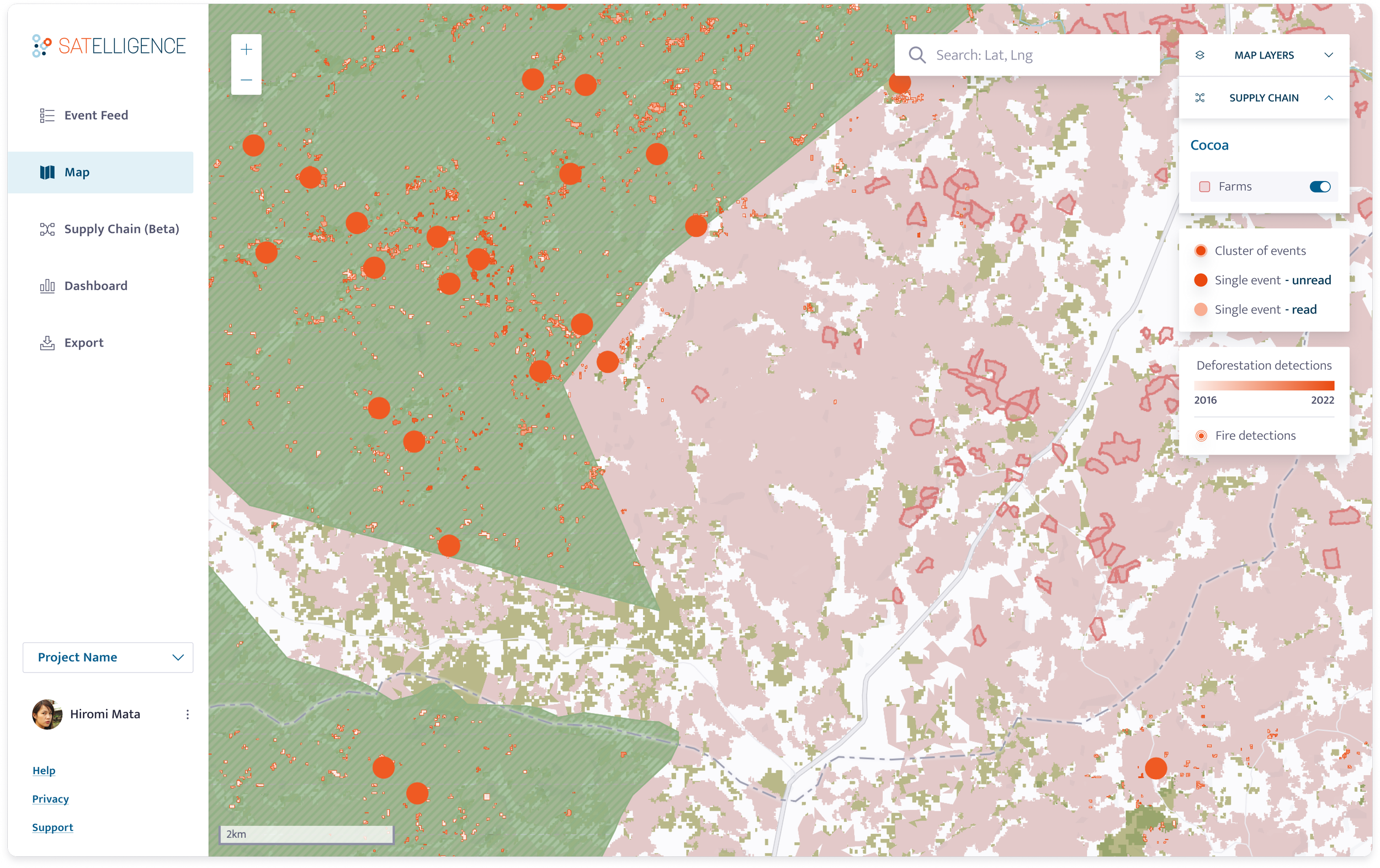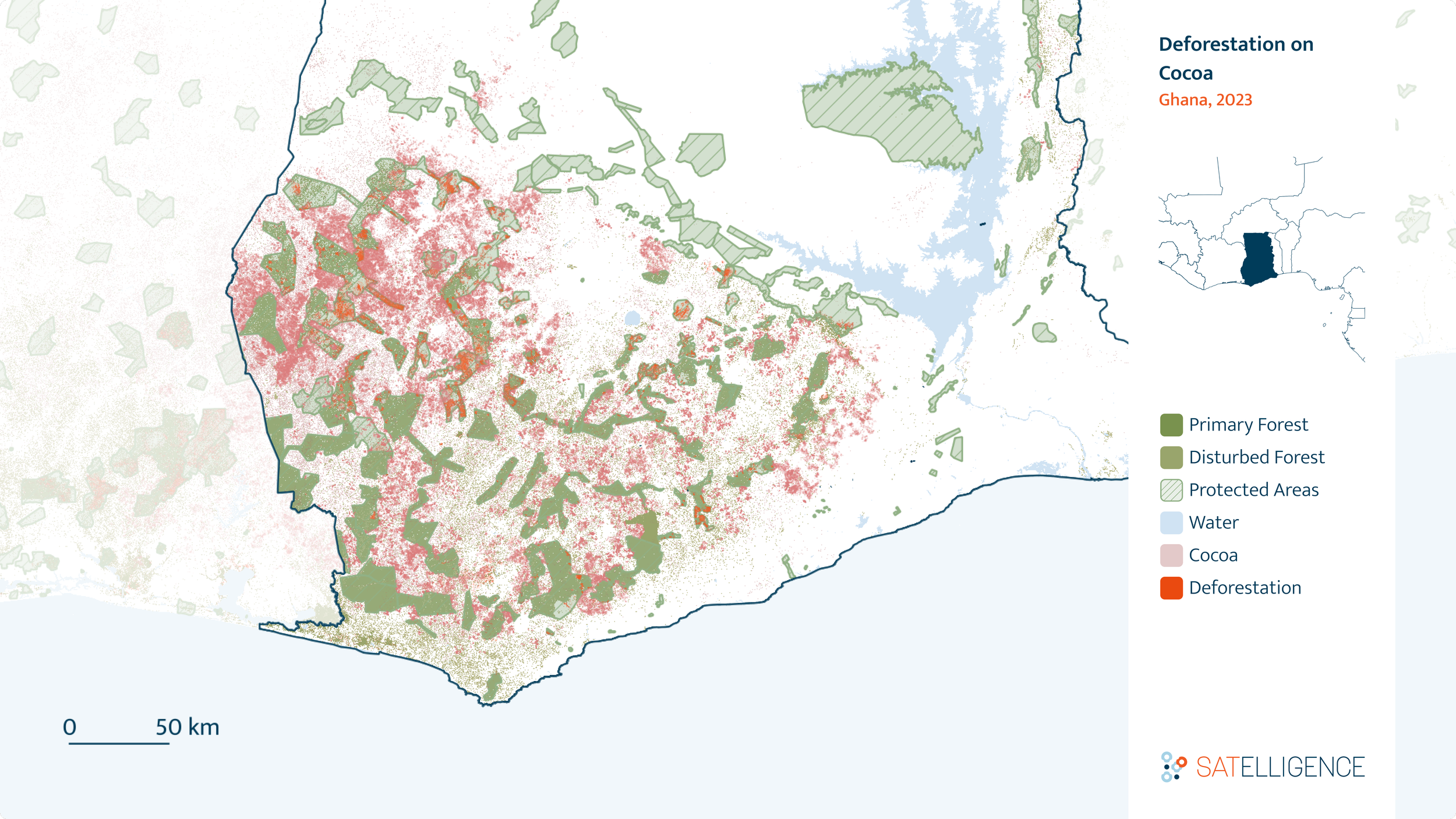In the complex world of chocolate production, one undeniable reality emerges: deforestation. As the primary driver of emissions in chocolate supply chains, its impact cannot be downplayed. The results of the Chocolate Scorecard have revealed a transformative solution—satellite-based deforestation monitoring. Notably, the best performers were chocolate companies that maximise the potential of this technology. They didn’t just monitor supply chain deforestation but also responded effectively through grievance systems and risk prevention activities. Moreover, companies with clear SBTi (Science-Based Targets) and roadmaps to achieving them also scored well, signalling a proactive approach towards sustainability.

Satellite Monitoring Scores a 10
With the EU Deforestation Regulation (EUDR) on the horizon, the cocoa sector faces a pivotal moment. The law, set to take effect in 2024, mandates a 100% deforestation-free supply chain for companies trading in the EU. Early adopters of satellite monitoring are positioned for success, as this technology becomes a cornerstone of regulatory compliance and market access.
“Companies need to develop and expand satellite monitoring systems for the locations they buy from. However, the responses to the survey suggest that only a few companies use satellite or remote sensing tools for deforestation detection.“
– Chocolate Scorecard
Forward-thinking industry pioneers are already ahead in the race for EUDR compliance, having committed to zero-deforestation through initiatives like the Cocoa & Forests Initiative (CFI). Nonetheless, data from the Chocolate Scorecard suggests that achieving 100% deforestation mapping across all sourcing areas remains a challenge for most companies. Satellite monitoring enables a proactive stance towards supply chain deforestation, empowering companies to identify high-risk areas and plan accordingly. Unlike traditional polygonal mapping methods, which rely on static boundaries and reveal deforestation after the fact, satellite monitoring facilitates preemptive action. Companies lagging in regulation readiness incurred low rankings on the Chocolate Scorecard, while frontrunners garnered extra recognition.
Keeping it Consistent
Inconsistent cut-off dates hampered many companies’ performance on the Scorecard. Cut-off dates stipulate a time from which a company commits to sourcing its commodities without deforestation. A 2017 cut off date, for example, means a company will not have to check if the land they’re using was deforested before 2017. If the land was cleared after 2020, they can’t use commodities grown on that land in their products if they want to trade in the EU in line with the EU’s recent Deforestation Regulation.
Under the CFI, some companies made just such a commitment, but the cut-off year varied among the companies assessed. Satellite monitoring can allow companies to verify land as deforestation free as far back as the 1980’s, so there’s no reason companies can’t agree on a consistent cutoff date. This kind of collaborative, cross-regional approach would go a long way towards stopping deforestation associated with bulk cocoa.
Similarly, companies that had varying levels of consistency in their sustainability strategies from country to country scored less.
Satelligence is able to offer global deforestation and other environmental risk monitoring with consistent accuracy due to its groundbreaking, ISAE-3000 Type 1 Certified algorithm that allows carbon modelling approaches to be adapted to any ecological region.

Turning Data into Action
Monitoring supply chain deforestation might be enough for a passing grade, but to excel companies will need to engage with stakeholders through effective grievance processes. Flimsy grievance processes that don’t take advantage of the latest technology were a commonality among low scorers. In many cases, there were staff grievance processes and not environmental ones, or, grievance mechanisms were not publicly accessible. Strong grievance policies lead to strong action, which is why the Consumer Goods Forum and Satelligence joined forces to help companies create robust grievance policies.
With satellite monitoring, companies can get automated alerts on deforestation, and independent, scientific evidence to augment environmental grievance procedures. Satellite monitoring is also able to identify risks like fire, or encroachment, so companies can capture risks before they get out of hand. While it’s important that companies highlight their sustainability progress, satellite monitoring technology allows them to back claims with hard evidence, respond to grievances as they occur, not after the fact, and to prioritise the allocation of their resources. Just like with any test, the Chocolate Scorecard gives more points to companies that can show their work.
Collaborate to Succeed
Another key finding from the results of the Chocolate Scorecard is the beneficial effect that industry collaboration, joint commitments and deforestation policies have had. This approach has proven to be successful in other commodity sectors such as palm oil. Supply chains are often interlinked, and, in many cases, companies ask for the same information from suppliers. Collaboration within the sector is win-win. It will drive greater levels of participation, improving the quality and quantity of available sustainability and concession data, and encourage further innovation. As data scientists and remote sensing engineers collaborate to advance the technology, sectoral partnerships like the CFI also advance available sustainability data, enhancing the impact of satellite-powered deforestation data. Geospatial monitoring providers like Satelligence can benefit from leveraging large customer networks, even deploying common event IDs between customers and suppliers to alert to deforestation and other risk events.
The Future of Sustainable Cocoa
Ending deforestation should be a driving force behind the cocoa sectors’ sustainability aspirations. The rapid development of new technologies in the sector are rapidly breaking down the barriers, and excuses, for industry laggards.
Embracing the potential of existing technologies can propel the cocoa sector beyond merely halting deforestation. It offers an opportunity to foster a diverse, nature-positive environment that fosters biodiversity and supports smallholders. However, significant penalties await companies that fail to comply with the EU Deforestation Regulation.
Fortunately, this year has witnessed improved Scorecard performance for those willing to adopt new technology and innovative business practices. The industry frontrunners are demonstrating that a profitable, deforestation-free cocoa sector is achievable. For those trailing behind, there’s hope on the horizon – Satelligence has recently secured major contracts, indicating the potential for even higher scores in the coming year.
